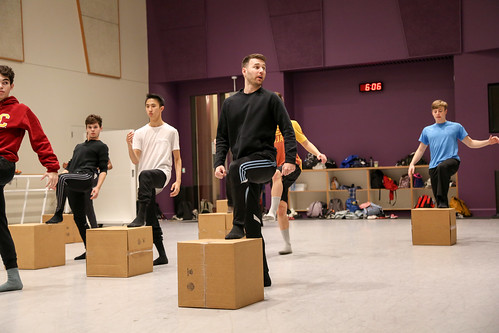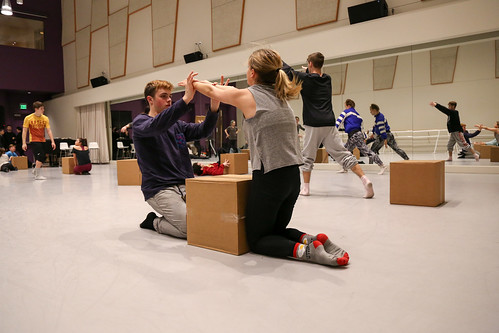Choreographing for the moment: Jessica Lee Keller and Christopher Scott
February 8, 2017

Christopher Scott in rehearsal with Kaufman students for the piece he and Keller are choreographing | Photo by Carolyn DiLoreto.
Since their first onscreen match-up on ABC’s Dancing with the Stars, dancers Jessica Lee Keller and Christopher Scott have been choreographing the interaction of several dance worlds. The two use their contrasting dance backgrounds—hers primarily balletic and his beginning with tap and hip-hop styles—to blend cohesive hybrid movements. Put them in a room full of USC Kaufman School of Dance “hybrid dancers” who have been exploring the New Movement for one to two years, and creativity takes off running.
Scott and Keller are working with students in the Glorya Kaufman International Dance Center this month to create an original work for the school. Referred to USC Kaufman individually (Keller had worked with Vice Dean Jodie Gates while dancing with Cedar Lake Contemporary Ballet, while Scott made contact through the school’s chief operations officer Renae Williams Niles), the two joined forces once again to set this new piece on a selection of dancers from the 50 BFA freshmen and sophomores.
Shifting concepts
“Working with the students dictated what the piece would be, what story we would tell,” Scott said.
The work was initially centered around a story personal to Scott and Keller, but after workshopping it for a week, they were inspired to adjust to a piece that would better fit the students’ interests. Now, the piece will be more oriented toward the creative process while Scott and Keller are choreographing, rather than the narrative they had planned.
“It melted and mashed into this thing that fit them,” Scott said. “There was an instant shift; they were just playing and then we added purpose and you could see the change. They know what’s going on now.”
The piece is built in two parts: one portrays youth and the other, adulthood. The sections focus on the contrast between innocent carelessness and self-conscious fear. Scott and Keller said that the transition period that college students inhabit allows the dancers to access both extremes.
Scott and Keller are adamant that the students influence the work.
“Stephanie [sophomore Stephanie Dai], for example, is really good at popping. It’s so interesting to see where she takes my movement,” Keller said. She saw the movement from the initial workshop stage as “dark and gritty,” but the cast of students was able to show more and different qualities that the choreographers want to be seen.
“It was cool seeing them collaborate and negotiate ideas, and how they also collaborated with us,” said Dai of rehearsing with the pair.
Negotiating time and process
Both Scott and Keller are based in Los Angeles, making it possible for them to fit a trip to the university into their busy workday schedules. They have small increments of time to rehearse at USC Kaufman—they are used to an eight-hour rehearsal period when choreographing—but they are accustomed to racing against the clock.
“In the commercial world, it’s go-go-go. You rehearse one day, you shoot one day, and then you know you can do it better but it’s already done,” Keller said.
Both choreographers described a battle with time as a challenge in Los Angeles, where the realities of commercial dance collide with the longer incubation period of concert performances. At USC Kaufman, with rehearsal time distributed over a month, Scott and Keller are able to focus more on building their process.
“We’re thinking less about the audience because it’s a process with students,” Scott said. After the first week or so workshopping movement, they generally move on to building the piece–setting the sequences they are choreographing. The second week of rehearsals will focus on the first section of the piece—the childhood section—and after a week away, the choreographers will return to finish the second and final section.
The students are very inspiring, Keller said. “It’ll be so interesting to see where their voice goes.”
By Celine Kiner







